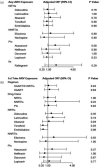Newborn Hearing Screenings in Human Immunodeficiency Virus-Exposed Uninfected Infants
- PMID: 28459118
- PMCID: PMC5407375
Newborn Hearing Screenings in Human Immunodeficiency Virus-Exposed Uninfected Infants
Abstract
Perinatal HIV infection and congenital cytomegalovirus (CMV) infection may increase the risk for hearing loss. We examined 1,435 infants enrolled in the Surveillance Monitoring of ART Toxicities (SMARTT) study of the Pediatric HIV/AIDS Cohort Study (PHACS) network, a prospective study of the safety of in utero antiretroviral (ARV) exposures. We determined the proportion of perinatally HIV-exposed uninfected (HEU) newborns who were referred for additional hearing testing, and evaluated the association between in utero ARV exposures and newborn hearing screening results. Using a nested case-control design, we also examined congenital CMV infection in infants with and without screening referral. Congenital CMV infection was determined based on CMV DNA detection using a nested PCR assay in peripheral blood mononuclear cells obtained within 14 days of birth. Among the 1,435 infants (70% black, 31% Hispanic, 51% male), 45 (3.1%) did not pass the hearing screen and were referred for further hearing testing. Based on exact logistic regression models controlling for maternal use of tobacco and ototoxic medications, first trimester exposure to Tenofovir was associated with lower odds of a newborn hearing screening referral [adjusted odds ratio (aOR) = 0.41, 95% confidence interval (CI): 0.14-1.00]. Exposure to Atazanavir was linked to higher odds of newborn screening referral, although not attaining significance [aOR = 1.84, 95% CI: 0.92-3.56]. Maternal ARV use may have varying effects on newborn hearing screenings. These results highlight the importance for audiologists to be knowledgeable of in utero ARV exposures in HEU children because of the possibility of higher referrals in these children.
Keywords: Cytomegalovirus; Hearing; Human Immunodeficiency Virus; In Utero Antiretroviral Exposure; Newborn.
Figures

References
-
- Early identification of hearing impairment in infants and young children. NIH Consensus Statement. 1993;11:1–24. - PubMed
-
- NIH Fact Sheet. Newborn Hearing Screening. Updated Oct 2010.
-
- Yoshinaga-Itano C, Apuzzo ML. Identification of hearing loss after age 18 months is not early enough. Am Ann Deaf. 1998;143(5):380–7. - PubMed
-
- Yoshinaga-Itano C, Sedey AL, Coulter DK, Mehl AL. Language of early- and later-identified children with hearing loss. Pediatrics. 1998;102(5):1161–71. - PubMed
Grants and funding
LinkOut - more resources
Full Text Sources
Medical
